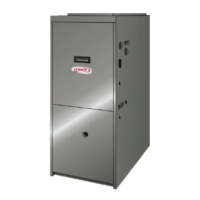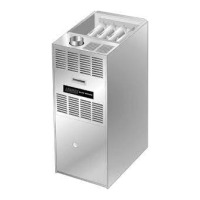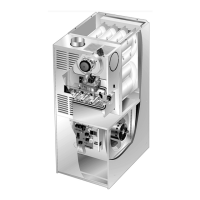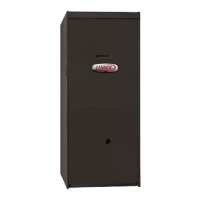Page 23
C− Venting Practices
The thickness of construction through which vent pipes may
be installed is 24" (610mm) maximum and 3/4" (19mm)
minimum. If a G51MP furnace replaces a furnace which
was commonly vented with another gas appliance, the size
of the existing vent pipe for that gas appliance must be
checked. Without the heat of the original furnace flue prod-
ucts, the existing vent pipe is probably oversized for the
single water heater or other appliance. The vent should be
checked for proper draw with the remaining appliance.
1. Use recommended piping materials for exhaust piping.
2. Secure all joints, including drip leg, gas-tight using ap-
proved cement.
Suspend piping using hangers at a minimum of every 5
feet (1.52m) for schedule 40
PVC and every 3 feet
(.91m) for ABS−DWV, PVC−
DWV, SPR−21 PVC, and
SDR−26 PVC piping. A suit-
able hanger can be fabri-
cated by using metal or
plastic strapping or a large
wire tie.
3. In areas where piping penetrates joists or interior walls,
hole must be large enough to allow clearance on all
sides of pipe through center of hole using a hanger.
4. Secure piping at the point where it exits the outside wall
or roof in order to prevent transmission of vibration to
the structure.
5. When furnace is installed in a residence where unit is
shut down for an extended period of time, such as a
vacation home, make provisions for draining condensate
collection trap and lines.
Exhaust Piping
NOTE − A 2" diameter street ell is strapped to the blower
deck of 48C−110 and 60C−110 units. Street ell must be
glued directly into the unit flue collar. See figure 20. A 3" to 2"
reducing ell is strapped to the blower deck of the 60D−135
units. In upflow or downflow applications, the reducing
ell must be
glued directly into the unit flue collar.
1. Choose the appropriate side for venting in upflow or
downflow positions. Exhaust piping exits from the top
of the unit in horizontal air discharge applications. Glue
the field−provided exhaust vent pipe (or provided street
ell or reducing ell in upflow or downflow applications) to
the flue collar. All cement joints should be made ac-
cording to the specifications outlined in ASTM D 2855.
Refer to pipe and fittings specifications and gluing pro-
cedures.
FIGURE 19
Exhaust Pipe Offset
12" Min.
12" Min.
12" Min.
12" Min.
Upflow Application
Rooftop Termination
Upflow Application
Side Wall Termination
Horizontal Application
Rooftop Termination
Horizontal Application
Side Wall Termination
FIGURE 18
STRAPPING
(metal, plastic
or large wire
ties)
